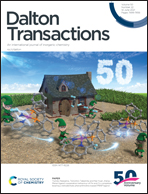Oxidation of Pd(ii) with disilane in a palladium-catalyzed disilylation of aryl halides: a theoretical view†
Abstract
Density functional theory (DFT) calculation has been used to reveal the mechanism of the Pd-catalyzed disilylation reaction of aryl halides. The DFT calculations indicate that the reaction starts with the oxidative addition of the C–I bond to the Pd(0) catalyst. Concerted metalation–deprotonation (CMD) can then generate a five-membered palladacycle. Insertion of Pd(II) into the Si–Si bond in disilane followed by two sequential steps of reductive eliminations yields the disilylation product and regenerates the Pd(0) catalyst. According to the NPA charge analysis along the reaction coordinates, the formal oxidative addition of the Si–Si bond to palladium could be considered as the insertion of palladium into the Si–Si bond. However, the conventional oxidative addition of the C–I bond to palladium is exactly an oxidation process with the electron transfer from the palladium atom to the C–I bond. Therefore, electron rich Pd(0) is beneficial for the oxidation process, and Pd(II) prone to acquire electrons is beneficial for the insertion process.



 Please wait while we load your content...
Please wait while we load your content...